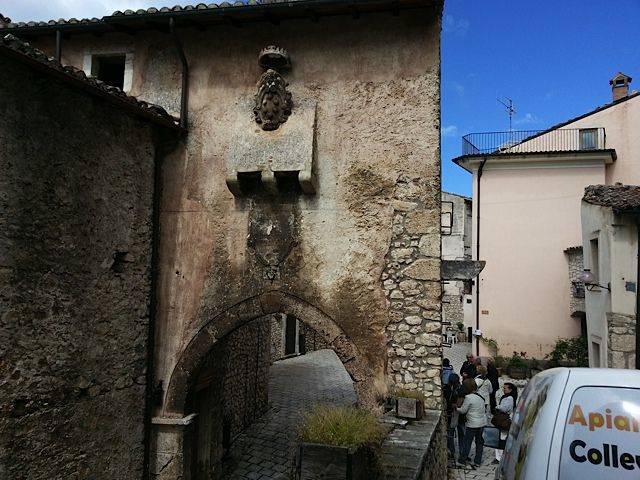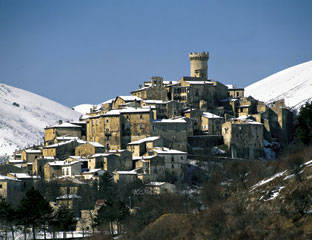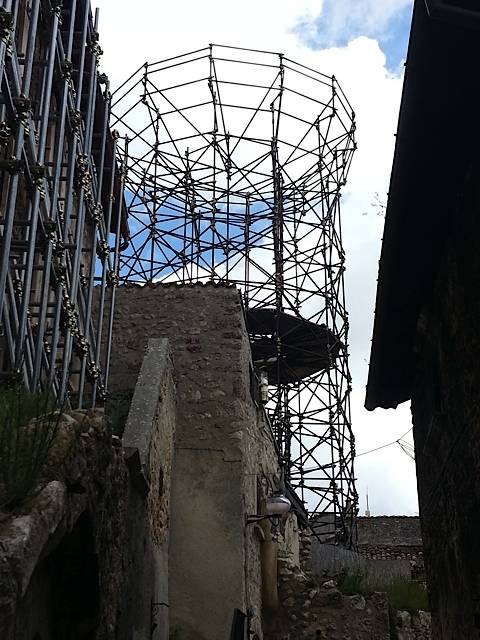Quake-Stricken Abruzzo Revisited
An ancient fortified borgo dating from circa 1300, Santo Stefano is situated at 1,250 m. high in the Gran Sasso mountain complex. However apparently remote, this has been a trade route since time immemorial, and the work "Sessanio" in the town name probably derives from the Latin Sextantio referring to a six-mile distance along a road in Roman times.
The town is a serendipitous blend of traditional white granite Abruzzo construction blended with Tuscan highlights because it was ruled by the Piccolomini banking family of Siena in the 1500s and then, through marriage, for almost two centuries by the Medici of Florence. The alliance with the Medici was about the wool trade; Florentine merchants purchased wool in the big market at L'Aquila for their textiles. The importance of the wool trade is shown in the transhumance census of the year 1474 in Puglia, which showed that Santo Stefano and three other tiny mountain towns had brought no fewer than 94,070 sheep southward down the mountains through the trattura reale (the route through the mountain passes that were the exclusive property of the king) to avoid the heavy snows of winter.
These cultural connections show from the Piccolomini came a fine defensive tower; from the Medici, architectural details and a number of churches scattered through the Abruzzo whose architecture reflects the Florentine style. One of these rises in nearby Castel del Monte, a fortified mountain borgo that vaunts a painting by Lorenzo di Monaldo, personally commissioned in the late 16th Century of Francesco de' Medici.
Santo Stefano was among the towns hit hard by the earthquake in 2009. Its great Piccolomini tower collapsed. Roofs caved in, walls were cracked. Today's visitors, many of them weekenders from Rome, walk down narrow alleys between centuries-old buildings whose walls are still held up by scaffolding. The original stones of which the tower was built have been collected and saved, but four years after the disaster local builders are still awaiting the promised government contribution for reconstruction. Finding the funds will not be easy during a tough recession, which continues to bring victims in almost every sector of the economy.
This reporter was last in the Abruzzo shortly after the quake, for a benefit concert offered by conductor Riccardo Muti. Hopes then were high for speedy reconstruction but so far little has been delivered by the Italian Government; indeed, according to the daily Il Messaggero in a headline April 24, "Earthquake: From the government, nothing." However, a second sum of E500 million was promised this April by Fabrizio Barca, Minister for the Territory in Mario Monti's cabinet and a leader of the left-leaning Partito Democratico. "The Government should undertake to provide about E 1 billion to cover the needs over the next 12 months and, in all, E 10.7 billion for a full reconstruction," said Barca.
Other reconstruction funds have arrived from outside Italy including a $2 million donation from Canada, where Ontario Province donated $500,000. On a more homespun level a group of private citizens organized an international conference last weekend called "Let's Blog Abbruzzo" for passionate bloggers willing to turn their skills to helping the Abruzzo emerge from the quake. Profits from participants' contributions are going toward two community causes that will help provide employment and increase tourism in the area.








































i-Italy
Facebook
Google+
This work may not be reproduced, in whole or in part, without prior written permission.
Questo lavoro non può essere riprodotto, in tutto o in parte, senza permesso scritto.